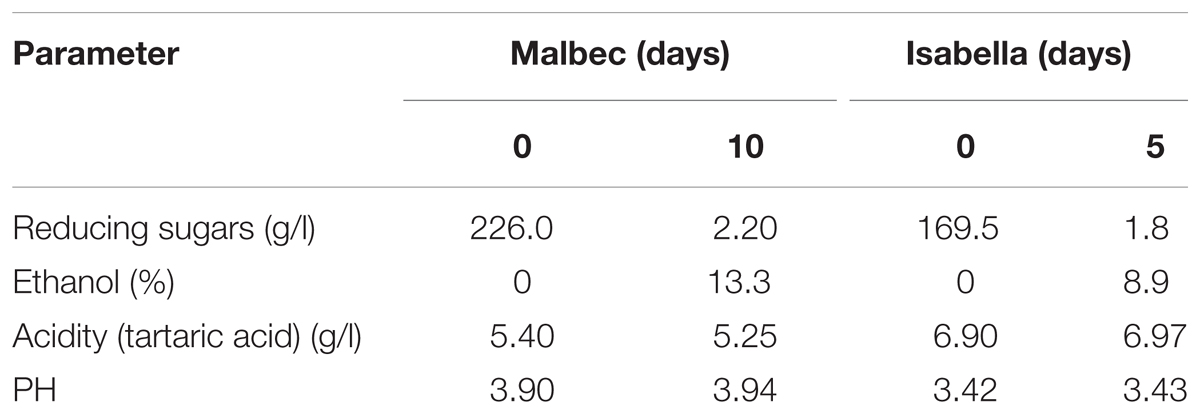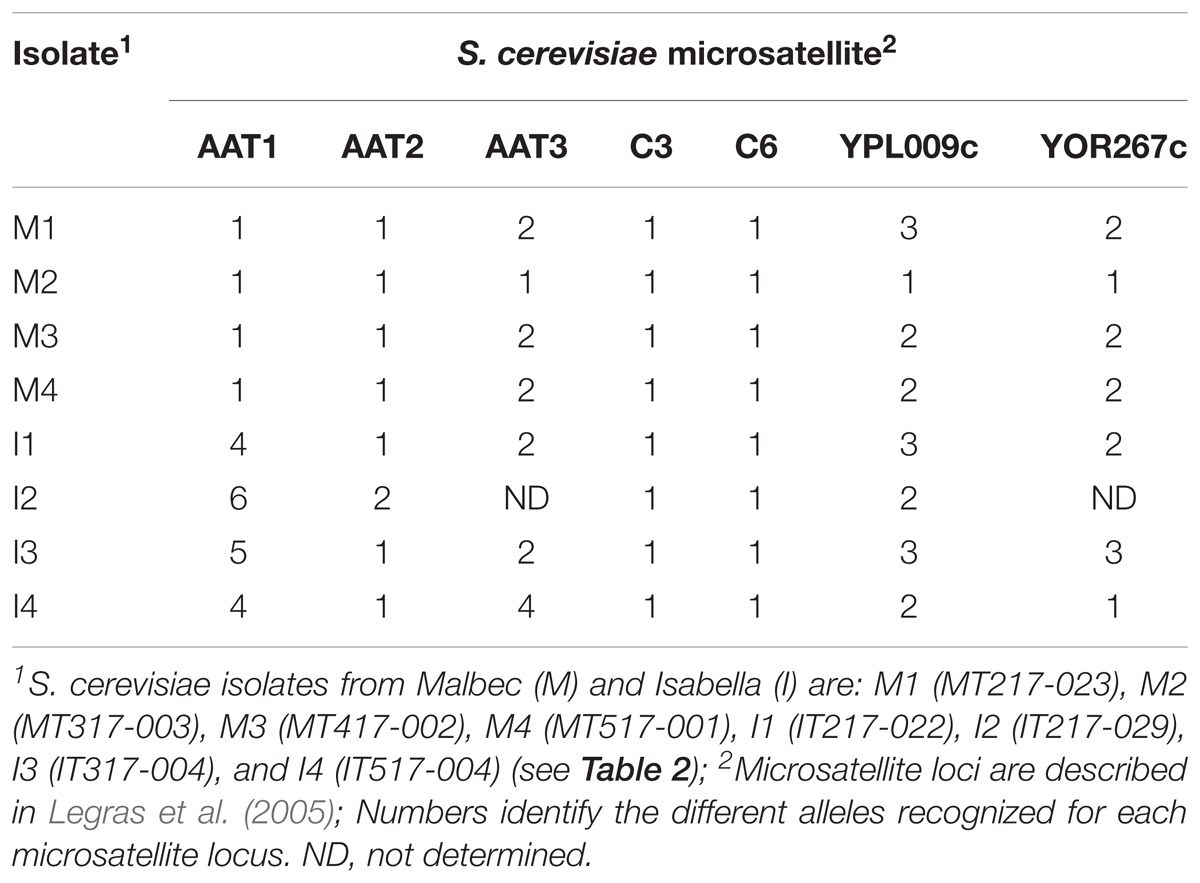- Laboratorio de Genética y Biología Molecular, IRNASUS-CONICET, Facultad de Ciencias Químicas, Universidad Católica de Córdoba, Córdoba, Argentina
Yeast communities associated with Vitis vinifera L. ecosystems have been widely characterized. Less is known, however, about yeast communities present in grapes and fermenting musts from Vitis non-vinifera ecosystems. Moreover, there are no comparative studies concerning yeast communities in grapes from V. vinifera L. and non-vinifera Vitis species in vineyards from a shared terroir. In this work, we have used a culture-dependent strategy, phenotypic analyses, and molecular genotyping, to study the most representative yeast species present in spontaneously fermenting musts of grapes harvested from neighboring V. vinifera L. (cv. Malbec) and V. labrusca L. (cv. Isabella) vineyards. Phenotypic analyses of H2S production, ethanol tolerance and carbon utilization, on randomly selected strains of each Hanseniaspora uvarum, Starmerella bacillaris and Saccharomyces cerevisiae strains, as well as microsatellite genotyping of S. cerevisiae isolates from each the Malbec and Isabella grape musts, suggest that V. vinifera L. and V. labrusca L. ecosystems could harbor different yeast strain populations. Thus, microbial communities in exotic Vitis species may offer opportunities to look for unique yeast strains that could not be present in conventional V. vinifera L. ecosystems.
Introduction
During alcoholic fermentation, a dynamic metabolic interaction between grape musts and their associated microbial communities shapes the final sensory and organoleptic character of wines (Fleet, 2008). Because of its scientific and industrial relevance, the study of the indigenous microbial communities in grapes and spontaneously fermenting grape must constitutes a major research area in oenology (Fleet, 2003; Jolly et al., 2014; Padilla et al., 2016; Varela, 2016; Varela and Borneman, 2017; Morgan et al., 2017). Culture-dependent and/or metagenomics approaches and DNA-based strategies have been used to characterize the complex and dynamic population of microorganisms in oenological ecosystems (Barata et al., 2012; Masneuf-Pomarede et al., 2016; Morgan et al., 2017). In these studies, a direct relationship has been recognized between grape microbiomas and terroirs, with the resulting specific microbial populations being a determining factor in the regional identity of vineyards, grapes, musts, and wines (Bokulich et al., 2014; Knight et al., 2015; Capece et al., 2016). A common pattern of development of yeast species, however, has been recognized in spontaneously fermenting musts from Vitis vinifera L. grapes, with non-Saccharomyces being the most common species at initial stages and Saccharomyces cerevisiae the dominant species at the middle and final stages of fermentation (Jolly et al., 2014). The rich diversity of non-Saccharomyces species, during the initial stages of fermentation, producing a variety of secondary metabolites, strongly contributes to the organoleptic signatures of wines (Jolly et al., 2006; Medina et al., 2013; Padilla et al., 2016; Varela, 2016).
While extensive research has been conducted on the complexity and dynamics of the yeast microbiota in the V. vinifera L. ecosystem (Varela and Borneman, 2017), fewer studies have examined the yeast communities in non-vinifera Vitis ecosystems. These non-conventional Vitis ecosystems may harbor a rich diversity of yeast species and strains (Raymond Eder et al., 2017). Recently, the diversity of yeasts in V. labrusca L. grapes and hybrids has been studied in vineyards from Brazil (Bezerra-Bussoli et al., 2013; Filho et al., 2017), the Azores Archipelago (Portugal) (Drumonde-Neves et al., 2016) and Argentina (Raymond Eder et al., 2017). These studies highlighted the remarkable diversity of non-Saccharomyces yeast species in a non-conventional Vitis ecosystem, and suggested the existence of specific Vitis-yeast species associations (Raymond Eder et al., 2017).
In this work, we report the identification and characterization of the main indigenous yeast species present during spontaneous fermentation of Malbec (V. vinifera L.) and Isabella (V. labrusca L.) grapes harvested from neighboring vineyards in Colonia Caroya (Córdoba, Argentina). Genetic and phenotypic characterization of a small number of isolates, representative of three relevant yeast species found in Malbec and Isabella ecosystems from this geographic region (i.e., Hanseniaspora uvarum, Starmerella bacillaris, and S. cerevisiae), suggest that spontaneously fermenting grape musts from different Vitis species could harbor different Vitis-specific yeast strain populations.
Materials and Methods
Spontaneous Fermentation of Malbec and Isabella Grape Musts
Malbec (V. vinifera L.) and Isabella (V. labrusca L.) grapes were harvested at their optimal ripeness stages from vineyards in Colonia Caroya (vintage of March, 2017), located at 31°02′00′′S / 64°05′36′′O and 491 meters above sea level, in the province of Córdoba, Argentina. The region has an annual rainfall of 765 mm and a mean temperature of 15.8°C. Separate spontaneous fermentations of a pool of destemmed and partially crushed Malbec and Isabella grapes were performed in a local cooperative cellar. Grapes from ∼80% of the Colonia Caroya’s Malbec and Isabella vineyards (i.e., 18–20 Ha each) are processed at this cellar. About 20% of these closely located, small vineyards (i.e., ∼1.5 Ha each), have intermixed rows of Malbec and Isabella plants. Must samples (70 liters) were fermented at 25–28°C in stainless steel tanks located in a room of the winery not previously used for winemaking. Musts were punched down twice a day and aliquots were taken daily for ten (i.e., 0–240 h) or five (i.e., 0–120 h) days from Malbec and Isabella musts, respectively, and stored in 30% (v/v) glycerol at -70°C.
Isolation of Yeast Strains From Malbec and Isabella Ecosystems
Appropriate dilutions of fermenting Malbec and Isabella grape must samples were plated in duplicate on YPD-Cm agar [yeast extract 1.0% (w/v), peptone 2.0% (w/v), glucose 2.0% (w/v), agar 2.0% (w/v), chloramphenicol 10 μg/ml] and incubated for 5 days at 25°C. Colony counts on YPD-Cm plates were used to estimate the total number of yeast during fermentation. To identify the most predominant yeast species present at the initial stages of fermentation (i.e., 0, 24, and 48 h), 20 yeast colonies were randomly isolated from each sampling time from YPD-Cm agar plates having 30–50 independent colonies. These high dilution plates give a high probability of isolating strains belonging to dominant yeast species (Osorio-Cadavid et al., 2008; Raymond Eder et al., 2017). Additional colonies were randomly isolated from Malbec and Isabella musts at advanced stages of fermentation (i.e., 120 and 96 h, for Malbec and Isabella, respectively) and isolates identified as S. cerevisiae (i.e., 43 from Malbec and 32 from Isabella) were chosen for further analyses. Must samples from Malbec and Isabella, from early stages of fermentation (i.e., 0, 24 and 48 h), were also plated in duplicate on WL-Cm agar [WL Nutrient agar medium (Oxoid) 7.5% (w/v), chloramphenicol 10 μg/ml] and incubated for 5 days at 25°C. Ten yeast colonies from each of the Malbec and Isabella must samples analyzed (i.e., 0, 24, and 48 h) showing distinctive phenotypes (i.e., morphology and/or color), were isolated from these plates. These colonies could correspond to rare yeast species present at each sampling point (Raymond Eder et al., 2017). A total of 255 yeast isolates were obtained from the Malbec and Isabella ecosystems. All isolated yeasts were streaked on YPD agar, grown for 48 h at 25°C in YPD, and stored at -70°C in YPD broth with 30% (v/v) glycerol added.
Molecular Identification of Yeast Species
Isolated yeasts were identified by PCR-RFLP and/or DNA sequencing of their 5.8-ITS (Internal Transcribed Spacer) rDNA regions (Esteve-Zarzoso et al., 1999). Total genomic DNA was extracted according to Raymond Eder et al. (2017). PCR was carried out using ITS1 and ITS4 primers (White et al., 1990). For PCR-RFLP, 10 μl of each of the PCR products were digested for 3 h at 37°C with the restriction enzymes Hinf I (New England BioLabs, United States) and/or Cfo I (Promega, United States) and the resulting DNA fragments were characterized by agarose [3.0% (w/v)] gel electrophoresis and analyzed using data from www.yeast-id.org. In most of the cases, yeast species identification was confirmed by Sanger sequencing of their 5.8-ITS rDNA regions and analysis using the BLASTN software NCBI1. Species identification was considered valid when the identity of a 5.8-ITS sequence and a reference sequence was 99–100%. Sequences from representative H. uvarum, S. bacillaris, and S. cerevisiae isolates were deposited in the NCBI GeneBank database (Table 2).
Phenotypic Analyses of H. uvarum, S. bacillaris, and S. cerevisiae Isolates
Four random isolates of each H. uvarum, S. bacillaris, and S. cerevisiae, from each of the spontaneously fermenting Malbec and Isabella grape musts, were analyzed for production of H2S, ethanol tolerance, and fermentation ability in media containing either glucose or fructose as carbon sources. Control yeast strains used in these studies have been reported (Raymond Eder et al., 2017). H2S production was tested on Biggy-agar (Bismuth Sulfite Glucose Glycine Yeast; Oxoid). In these studies, 3 × 104 cells (3 μl) were spotted on Biggy agar, incubated at 25°C for 3 days, and graded using the following visual color scale: 1 (white), 2 (cream), 3 (light brown), 4 (brown), and 5 (dark brown) (Sipiczki et al., 2001). Ethanol tolerance analyses were performed according to Belloch et al. (2008) with some modifications. Cells (3 × 104 cells; 3 μl) were spotted on low dextrose [i.e., glucose 0.5% (w/v)] YP agar supplemented with either 0, 2.5, 5.0, 7.5, 10.0, 12.5, or 15.0% (v/v) of ethanol and incubated at 22°C. Growth was considered positive when colony development was recognized with the naked eye.
A simple weight loss microassay, dependent on CO2 release (Quirós et al., 2010), was designed to characterize glucose and fructose fermentation profiles of the H. uvarum, S. bacillaris, and S. cerevisiae isolates. Similar small scale fermentation assays have been recently published (Liccioli et al., 2011; Peltier et al., 2018). In our studies, strains were grown during ∼15 h at 25°C without agitation in 15 ml Falcon tubes containing 5 ml of YP medium supplemented with either glucose 10.0% (w/v) (YPD-10) or fructose 10.0% (w/v) (YPF-10). Duplicated 1.5 ml Eppendorf tubes, containing 1.0 ml liquid of YPD-10 or YPF-10, were inoculated with cells (107/ml) from the YPD-10 and YPF-10 cultures, respectively, and maintained at 25°C without agitation. Microtubes contained a 0.8 mm perforation on its cap, covered with a small piece of cotton, to allow CO2 efflux. Tubes were weighed immediately after inoculation and every 24 h for 4 days, using non-inoculated tubes as control of weight loss via evaporation. Fermentation rates were expressed as weight loss (i.e., CO2 release) in function of time (i.e., g.l-1.h-1).
S. cerevisiae Microsatellite Genotyping
Saccharomyces cerevisiae isolates from Malbec and Isabella musts were genotyped using seven microsatellite loci (i.e., SCAAT1, SCAAT2, SCAAT3, C3, C6, YPL009c, and SCYOR267c) (Legras et al., 2005). PCR reactions contained 100 ng of genomic DNA, 1.5 mM MgCl2, Taq polymerase buffer 1X (Invitrogen, United States), 200 μM dNTPs, 10 pmol of each primer and 1.25 units of Taq polymerase (Invitrogen, United States). Amplification reactions were performed in a MJ Mini Bio-Rad thermocycler (Bio-Rad, United States) using an initial denaturation step at 95°C for 5 min, followed by 35 cycles of 95°C for 30 s, annealing at 57°C for 45 s, extension at 72°C for 1 min followed by a final extension at 72°C for 10 min. PCR products were separated in 8.0% polyacrylamide gels using TBE as the running buffer. Gels were stained with ethidium bromide, photographed under UV light and allele sizes were determined using the 100-bp-DNA-ladder (Inbio Highway, Argentina) as a reference molecular size standard.
Results
Malbec (V. vinifera L.) and Isabella (V. labrusca L.) Spontaneously Fermenting Grape Musts
Standard oenological analyses of Malbec and Isabella grape musts were performed at the beginning and the end of fermentation (Table 1). As expected, from its low initial levels of total reducing sugars, Isabella grape must fermentation was completed in 5 days, while spontaneous fermentation of Malbec grape must took 10 days. Ethanol concentration in completely fermented Isabella grape must was 8.9% (v/v), which is ∼1% (v/v) lower than expected from its initial concentrations of reducing sugars (169.5 g/l) (Table 1).
Population Dynamics and Main Cultivable Yeasts in Spontaneously Fermenting Malbec and Isabella Grape Musts
The population dynamics of cultivable yeast species in the Malbec and Isabella ecosystems were analyzed from time t0 to t120, corresponding to the initial stages of fermentation of Malbec and the entire fermentation period of Isabella (Figure 1). The total yeast populations in both ecosystems started with similar counts, and increased similarly as fermentation progressed (Figure 1). The highest total yeast count in fermenting Isabella grape must was observed at t96 while fermenting Malbec must reached its highest yeast count at t120 (Figure 1). As expected, S. cerevisiae was the most predominant yeast species recognized among 75 isolates obtained at the middle/advanced stages of fermenting Malbec and Isabella musts (i.e., t72–t120) (not shown). Based on this observation, our analyses of the predominant non-Saccharomyces species in the Malbec and Isabella ecosystems were limited to the early stages of spontaneous fermentation (i.e., t0, t24, and t48), at which a total of 180 isolates were identified by PCR-RFLP and/or DNA sequencing of their 5.8-ITS (Internal Transcribed Spacer) rDNA regions (Figure 2).
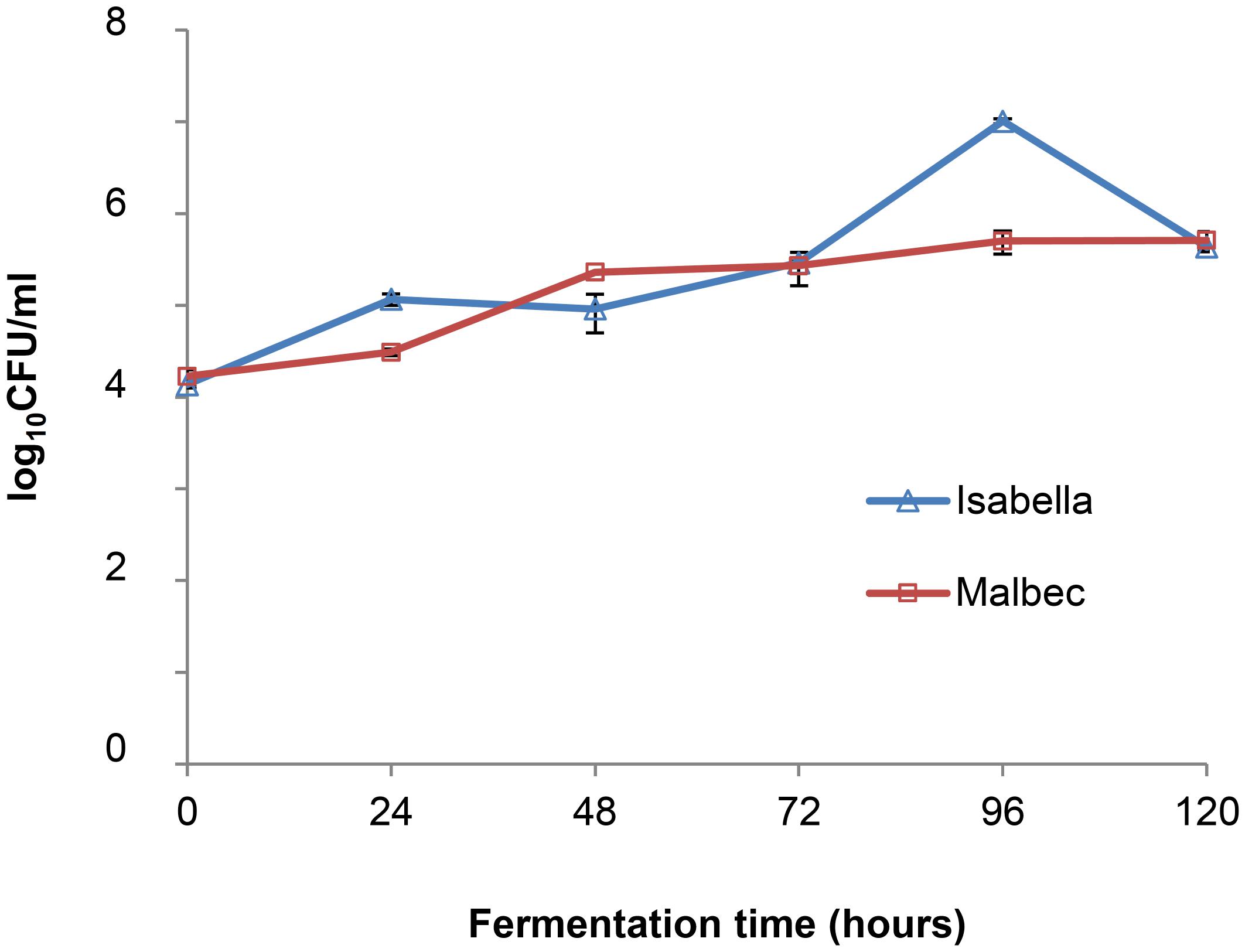
FIGURE 1. Population dynamics of total yeasts at initial times of spontaneous fermentation of Malbec and Isabella grape musts.
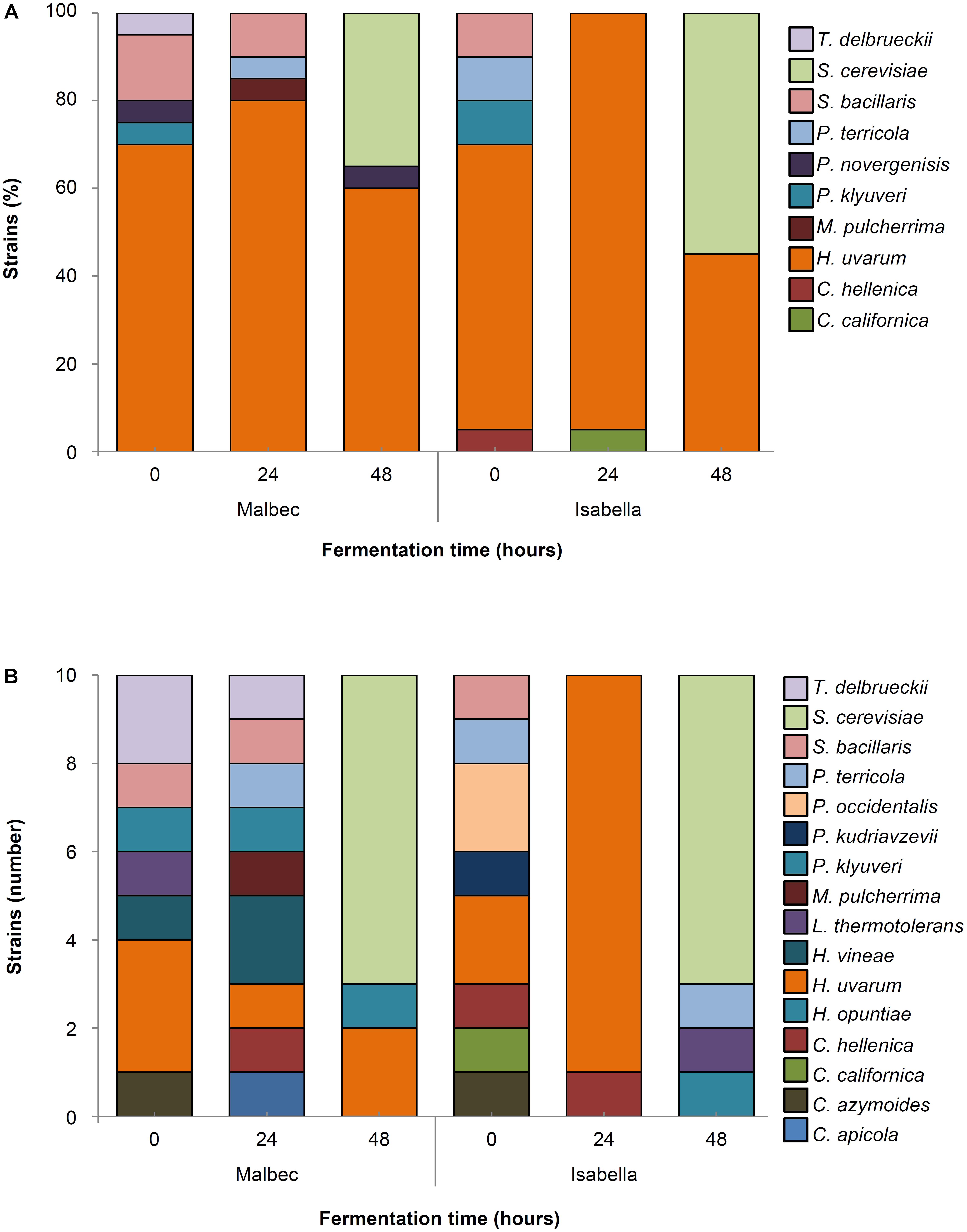
FIGURE 2. Main contributing yeast species during spontaneous fermentation of Malbec and Isabella grape musts. Percentages represent the relative contribution of the indicated yeast species among 120 randomly selected colonies (20 isolates/sampling time; 60 isolates from each Malbec and Isabella) obtained at the indicated times of fermentation (A). Yeast species identified among 60 rare colonies (10 isolates/sampling time; 30 isolates from each Malbec and Isabella) isolated from WL-Cm Nutrient agar plates at the indicated times of fermentation (B).
A great diversity of non-Saccharomyces species was evidenced among the yeast isolated from both Malbec and Isabella ecosystems (Figure 2). H. uvarum was the most common species isolated at early stages of fermentation of Malbec (t0, t24, and t48) and Isabella (t0 and t24) grape musts (Figure 2A). Other non-Saccharomyces yeast species identified in both Malbec and Isabella musts were Candida azymoides, Candida hellenica, Lachancea thermotolerans, Pichia klyuveri, Pichia terricola, and Starmerella bacillaris. Interestingly, Torulaspora delbrueckii, Hanseniaspora vineae, and Metschnikowia pulcherrima, were not among the yeast species identified in Isabella (Figure 2). Candida californica, previously recognized in Isabella fermenting must (Raymond Eder et al., 2017), was also isolated from Isabella in this work (i.e., at t0 and t24). P. occidentalis and P. kudriavzevii were isolated only from fermenting Isabella must (Figure 2B) while P. norvegensis was isolated only from fermenting Malbec must. S. cerevisiae, not isolated at initial stages of spontaneous fermentation, was the predominant yeast species in Isabella must at t48, and started to become dominant at the same fermentation time in Malbec must.
H2S Production by H. uvarum, S. bacillaris, and S. cerevisiae Isolates From the Malbec and Isabella Ecosystems
In order to explore possible phenotypic differences among S. bacillaris, H. uvarum, and S. cerevisiae isolates from the Malbec and Isabella ecosystems, we analyzed the production of H2S in four randomly selected isolates from each of these species. H2S production varied greatly among yeast species, as well as between isolates of the same species from the same ecosystem (Figure 3 and Table 2). Interestingly, however, most of the S. cerevisiae isolates from Malbec (3 out of 4) showed higher production of H2S than their counterparts isolated from Isabella grape must (Figure 3). S. bacillaris, on the other hand, was the species with the most consistent production of relatively high levels of H2S, compared to H. uvarum and S. cerevisiae (Figure 3 and Table 2).
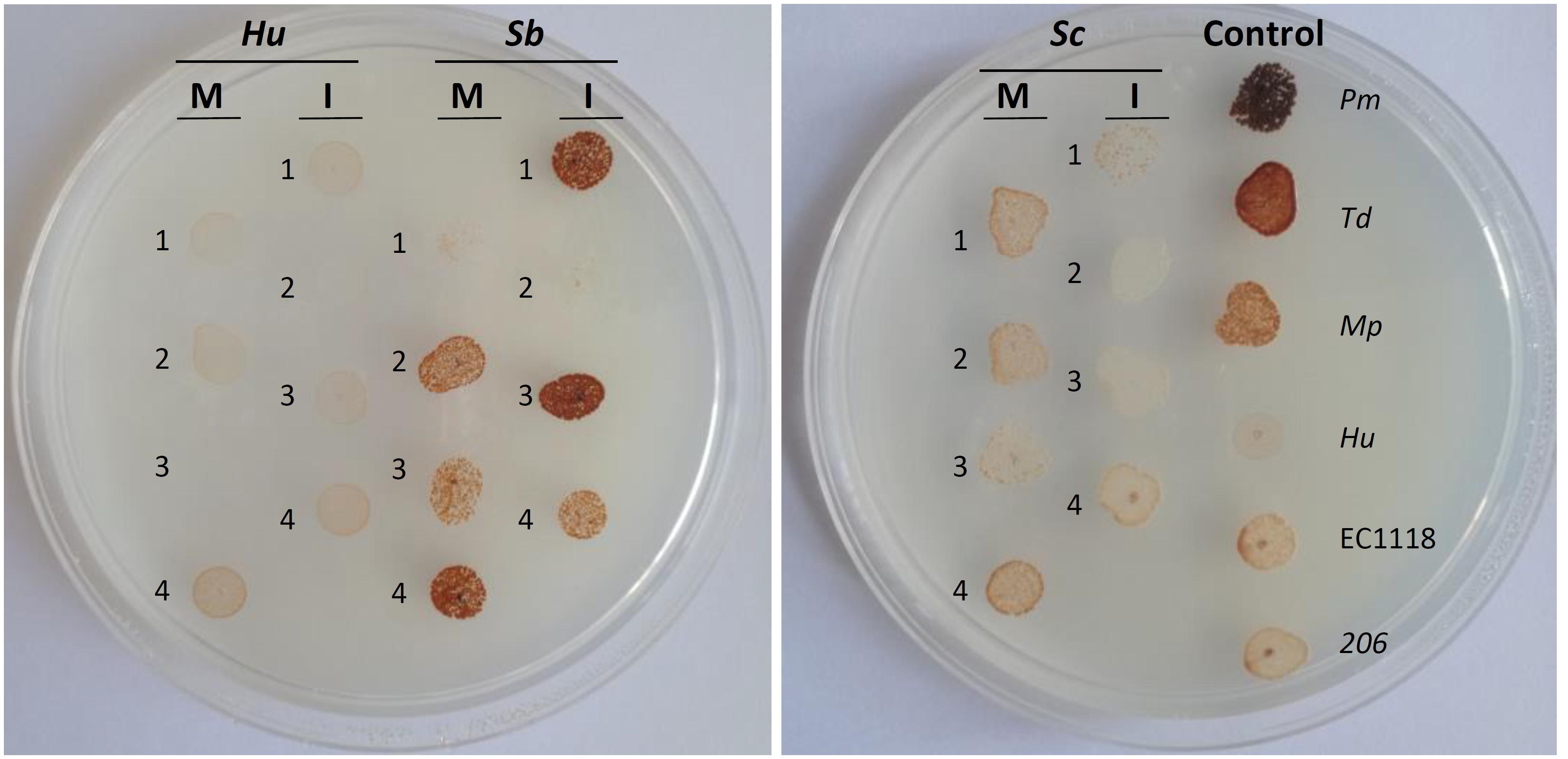
FIGURE 3. H2S production. Isolates 1 to 4 from each H. uvarum (Hu), S. bacillaris (Sb), and S. cerevisiae (Sc) (Table 3), from the Malbec (M) and Isabella (I) ecosystems, as well as control strains P. membranifaciens (Pm), T. delbrueckii (Td), M. pulcherrima (Mp), H. uvarum (Hu), and S. cerevisiae (EC1118 and 206), were grown in Biggy medium and H2S production was scored (see Table 2) as indicated in the Material and Methods section.
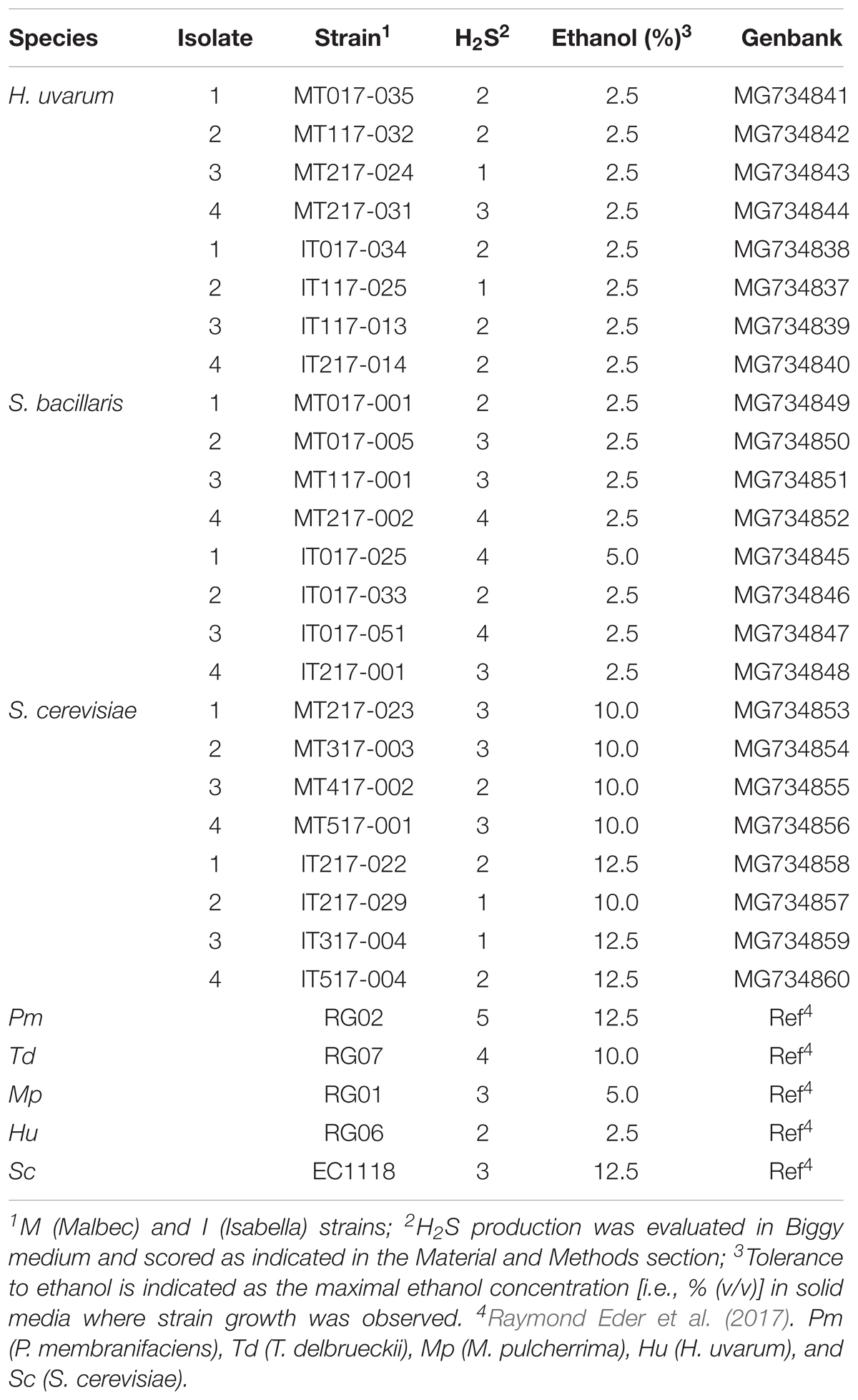
TABLE 2. Phenotypic analyses of H. uvarum, S. bacillaris, and S. cerevisiae isolates from neighboring Malbec and Isabella ecosystems.
Ethanol Tolerance of H. uvarum, S. bacillaris, and S. cerevisiae Isolates From the Malbec and Isabella Ecosystems
Tolerance to ethanol of the 24 randomly selected H. uvarum, S. bacillaris, and S. cerevisiae isolates was determined according to their ability to grow in solid media supplemented with different concentrations of ethanol (i.e., 2.5–15.0%). In these studies, S. bacillaris isolates from both Malbec and Isabella ecosystems were able to grow only in media containing relatively low levels of ethanol (i.e., 2.5 to 5.0%) (Table 2). Most of the S. cerevisiae isolates from Isabella (3 out of 4) showed higher ethanol tolerance (i.e., 12.5%) than the four characterized S. cerevisiae isolates from Malbec must (i.e., 10.0%). The relatively low tolerance to ethanol of the Malbec S. cerevisiae isolates was also observed in S. cerevisiae isolates from more advanced stages of fermentation of the Malbec must (not shown). Similar results were obtained when ethanol tolerance of the H. uvarum, S. bacillaris, and S. cerevisiae isolates was assayed in liquid media (not shown).
Fermentation Profiles of H. uvarum, S. bacillaris, and S. cerevisiae Isolates From the Malbec and Isabella Ecosystems
A simple microtube assay was designed to explore possible phenotypic differences in glucose versus fructose utilization among the H. uvarum, S. bacillaris, and S. cerevisiae isolates from the Malbec and Isabella ecosystems. Remarkable differences in the fermentation rates between the three analyzed yeast species were observed at initial stages of fermentation (Figure 4). Based on this observation, the initial (i.e., 24 h) fermentation rate phenotype was used to compare the H. uvarum, S. bacillaris, and S. cerevisiae isolates. Results from these studies showed a discrete heterogeneity in fermentation rate phenotypes, both in glucose- and fructose-containing media, for the various isolates analyzed (Figure 5). H. uvarum isolates from Isabella showed slightly higher fermentation ability when grown in YP medium containing fructose versus glucose as the major carbon source (Figure 5). Interestingly, the average initial fermentation rate phenotype of S. bacillaris isolates from Malbec and Isabella were ∼1.5- and ∼1.9-fold higher in fructose than in glucose, respectively (Figure 5).
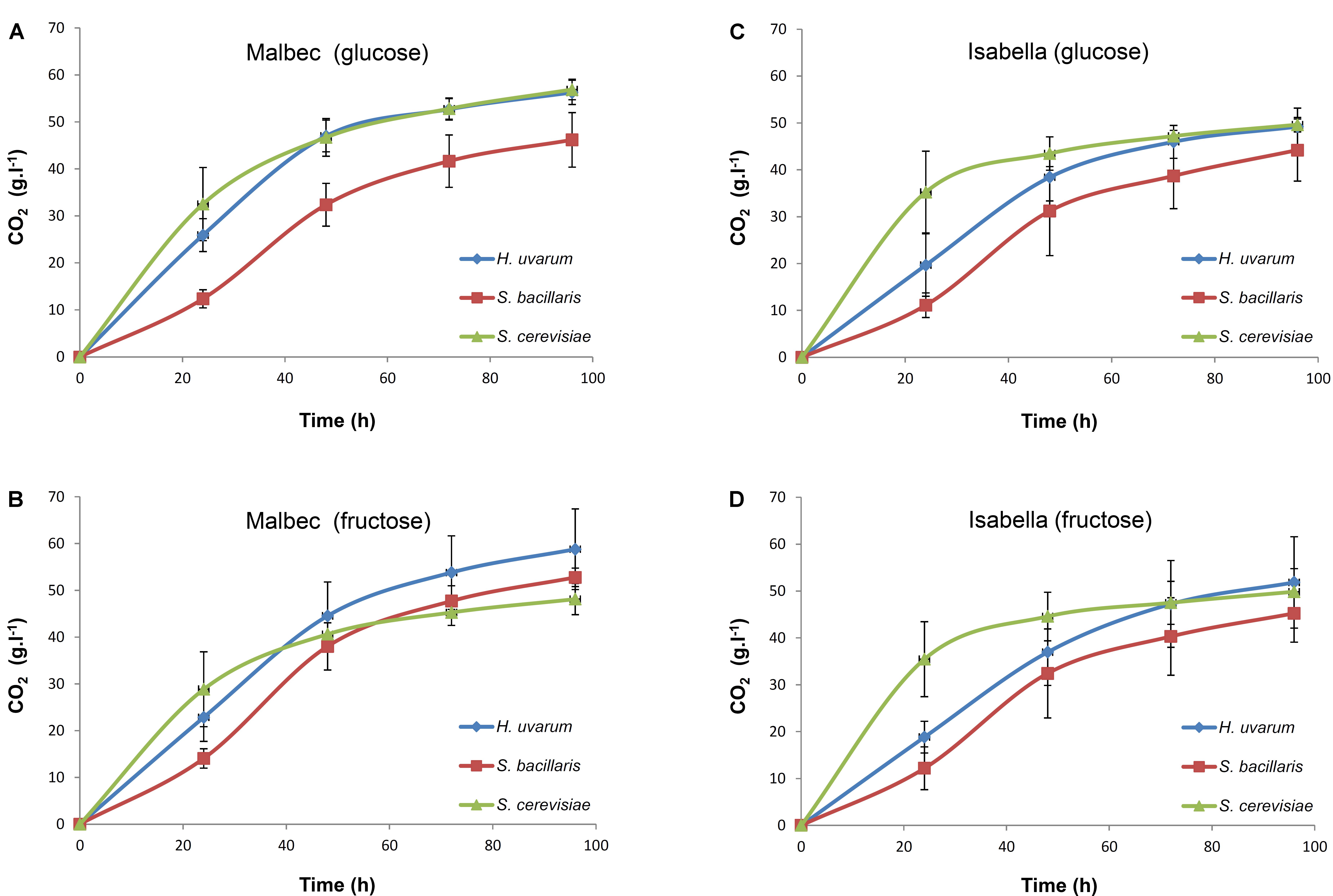
FIGURE 4. Fermentation profiles of H. uvarum, S. bacillaris, and S. cerevisiae isolated from the Malbec and Isabella ecosystems. Average weight loss (i.e., CO2 release) of 1.0 ml cultures of the Malbec (A,B) and Isabella (C,D) H. uvarum, S. bacillaris, and S. cerevisiae isolates, indicated in Table 2, grown during 96 h in media containing 10% (w/v) glucose (A,C) or 10% (w/v) fructose (B,D) as carbon sources. Each point represents the average value (i.e., expressed as g.l-1.h-1) of eight independent cultures (i.e., duplicate cultures of the four isolates tested for each species) ± SD.
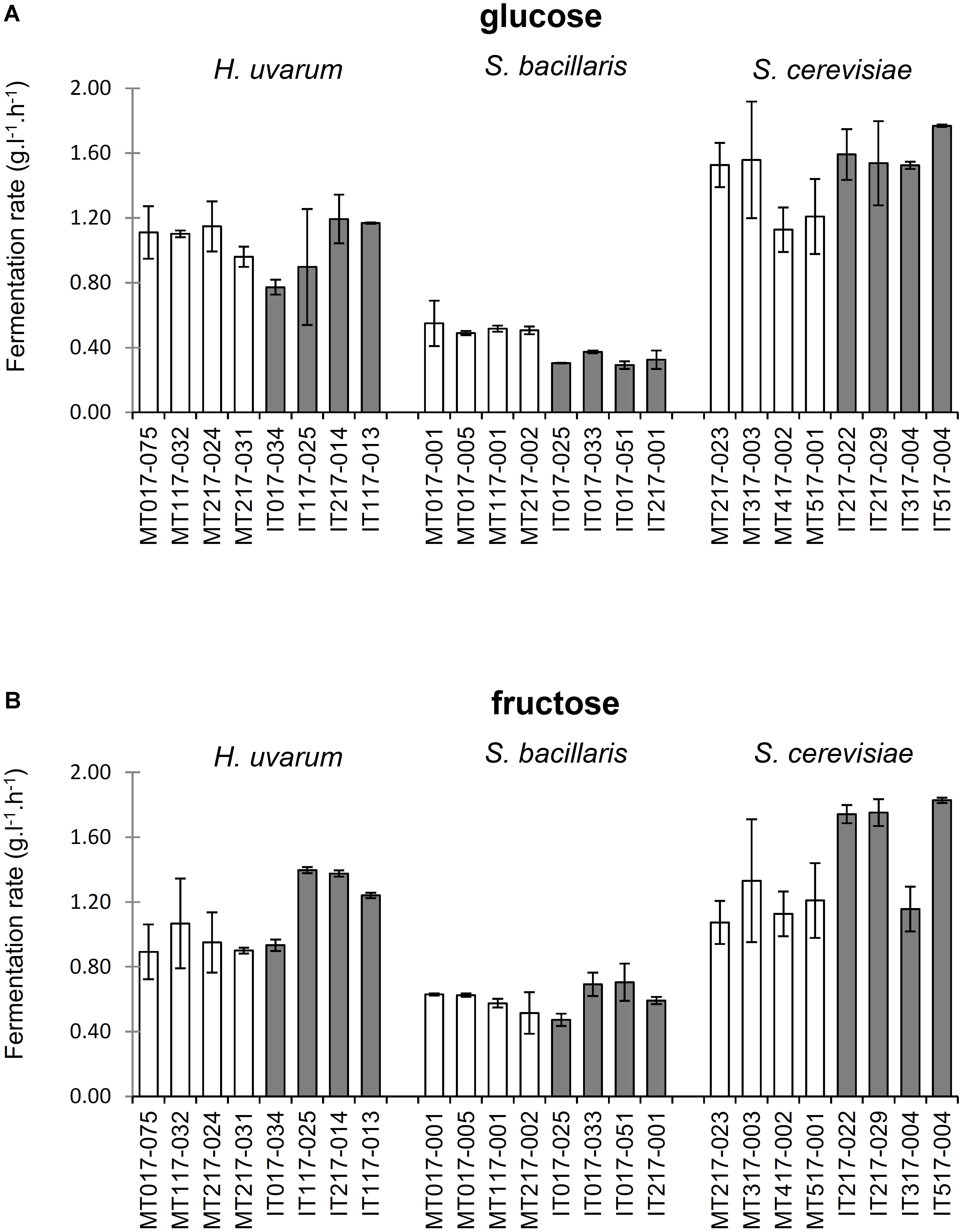
FIGURE 5. Fermentation rates of H. uvarum, S. bacillaris and S. cerevisiae isolates from Malbec and Isabella ecosystems. Fermentation rate values (g.l-1.h-1) were obtained by linear regression of culture weight loss values for the first 24 h of cultures of the indicated isolates in media supplemented with either glucose (A) or fructose (B). Experiments were performed in duplicate and bars represent the linear regression error of the 95% confidence band.
Microsatellite Genotyping of S. cerevisiae Isolates From Malbec and Isabella Ecosystems
Microsatellite genotyping was used to determine if the S. cerevisiae isolates from the Malbec and Isabella ecosystems were genetically related. Results from the analyses of seven highly informative microsatellite loci (Legras et al., 2005) are shown in Table 3. Loci C3 and C6 were non discriminant and M3 and M4 isolates could not be differentiated in the analysis. Results from Table 3 show that Malbec and Isabella fermenting musts harbor a genetically diverse population of S. cerevisiae strains.
Discussion
Spontaneously fermenting grape musts constitute rich microbial ecosystems, harboring a remarkable diversity of yeast species. The assembly and evolution of this microbiota, from grape development to the end of must fermentation, is conditioned by the intrinsic biological properties of the grapevine, geographic and climatic conditions at the vineyard, agricultural practices and winemaking procedures (Bokulich et al., 2014; Knight et al., 2015; Jara et al., 2016; Drumonde-Neves et al., 2017).
We have recently proposed that some yeast species may be specifically associated with some Vitis species (Raymond Eder et al., 2017). Eventually, different Vitis species may harbor specific yeast communities (i.e., yeast species and/or strains of a given yeast species) even in neighboring Vitis ecosystems. In this work we explored this hypothesis by studying yeast isolates, from neighboring Malbec (V. vinifera L.) and Isabella (V. labrusca L.) vineyards, representative of the three major species recognized in Isabella (i.e., H. uvarum, S. bacillaris, and S. cerevisiae) (Raymond Eder et al., 2017). H. uvarum was the predominant non-Saccharomyces species in the Malbec and Isabella ecosystems, both at early and middle stages of fermentation. In a previous work, we identified S. bacillaris as the main yeast species present at early stages of fermentation of Isabella grapes harvested in the same geographic region (i.e., vintage 2015) (Raymond Eder et al., 2017). A similar predominance of either H. uvarum or C. stellata (reclassified to S. bacillaris; Csoma and Sipiczki, 2008; Duarte et al., 2012), in consecutive vintages in the same geographic region, has been reported (Beltran et al., 2002). In addition to H. uvarum, a variety of non-Saccharomyces species were isolated at early stages of Isabella must fermentation. This diversity quickly decreased between t0 and t24 and three main yeast species (i.e., H. uvarum, C. californica, and C. hellenica) were recognized following 1 day of fermentation. In fermenting Malbec grape must, on the other hand, the great diversity of yeast species found at the beginning of fermentation continued at t24 and t48, when S. cerevisiae species started to develop.
A total of seventeen different yeast species were isolated from both Malbec and Isabella musts at early stages of fermentation. Although all of these yeast species have previously been described in winemaking environments, their relative contribution to the different neighboring Vitis ecosystems analyzed in this work varied. For example, H. vineae, M. pulcherrima, and T. delbrueckii, yeast species commonly found in V. vinifera L. grape musts (Jolly et al., 2006), were isolated only from the Malbec ecosystem. The relatively low number of isolates (i.e., 80 isolates from each Malbec and Isabella), however, does not allow to conclude if these yeast species have preferential association with the Malbec versus the Isabella ecosystem. Interestingly, M. pulcherrima was not identified in fermenting Isabella must from grapes analyzed in this work nor in grapes harvested from the same vineyards in a previous vintage (Raymond Eder et al., 2017). In addition, M. pulcherrima was identified in V. labrusca L. grapes from the Azores Archipelago, but only with very low frequency (1.08% of the total isolates) (Drumonde-Neves et al., 2016). On the other hand, the rare yeast species C. californica, isolated from Isabella spontaneously fermenting must in the vintage of year 2015 in Colonia Caroya (Raymond Eder et al., 2017), was identified again in the same Isabella ecosystem in this work (i.e., vintage 2017). Moreover, C. californica was not found among a total of 150 isolates from the analyzed Malbec ecosystem. Taken together, these observations suggest that M. pulcherrima and C. californica could have apparent selective and/or preferential association with V. vinifera L. and V. labrusca L. ecosystems, respectively. However, although C. azymoides was originally found associated with fermenting must only from V. labrusca L. grapes (Drumonde-Neves et al., 2016; Raymond Eder et al., 2017), this yeast species was also recognized in the Malbec ecosystems studied in this work. Remarkably, C. azymoides has not previously been recognized in the extensive worldwide studies performed on the yeast microbiota of V. vinifera L. grapes and musts. Therefore, we hypothesize that C. azymoides isolates may be limited to some specific terroirs, and/or its presence in our Malbec samples may be dependent on the close location of V. vinifera L. and V. labrusca L. vineyards in Colonia Caroya.
Phenotypic analyses of H2S production showed a remarkable diversity among the analyzed S. cerevisiae isolates from Malbec and Isabella. Microsatellite genotyping of these S. cerevisiae isolates showed that, with the exception of isolates M3 and M4, they correspond to genetically different strains. Interestingly, Isabella’s S. cerevisiae isolates I2 and I3, which are genetically different, were the lowest producers of H2S, even when compared with the industrial strain EC1118. Additional characterization of a larger number of S. cerevisiae isolates could indicate if medium and low H2S producer strains are preferentially associated with the Malbec and Isabella ecosystems, respectively. H. uvarum and S. bacillaris isolates were low and high producers of H2S, respectively. Although the observed phenotypes suggested genetic heterogeneity among the analyzed H. uvarum and S. bacillaris isolates, no specific association of the isolates with their Malbec or Isabella ecosystems was observed.
Hanseniaspora uvarum and S. bacillaris isolates, from both the Malbec and Isabella ecosystems, showed a relatively low tolerance to ethanol. Although H. uvarum and S. bacillaris have been found at final stages of spontaneous fermentation of V. vinifera L. musts (Combina et al., 2005; Tofalo et al., 2011; Aponte and Blaiotta, 2016; Tristezza et al., 2016), low tolerance to ethanol of S. bacillaris from fermenting Isabella grape must has been described (Raymond Eder et al., 2017). On the other hand, S. cerevisiae isolates from the Malbec or Isabella musts showed some mild differences in tolerance to ethanol. Ethanol tolerance of the Malbec S. cerevisiae isolates was similar among isolates obtained at either medium or advanced stages of fermentation (not shown). Interestingly, ethanol yield in completely fermented Isabella grape must was lower than expected. This phenomenon, which is not observed for Malbec or other V. vinifera L. grape musts from Colonia Caroya (Córdoba, Argentina), is typically observed in spontaneously fermented Isabella grape musts from this geographic region, regardless of the vintage (Raymond Eder et al., 2017).
Additional evidence on the phenotypic diversity of yeast species isolated from the Malbec and Isabella ecosystems was obtained from the analysis of their fermentation profiles in media containing either glucose or fructose as the main carbon source. Interestingly, some S. cerevisiae isolates appear to have a slightly higher fermentation rate in fructose than in glucose media, which was unexpected given the glucophilic character of this yeast species. Also interestingly, S. bacillaris isolates from the Malbec ecosystem showed higher fermentation rates in media containing glucose than S. bacillaris isolates from Isabella.
Finally, our results show a remarkable biodiversity among main yeasts isolated from two different neighboring Vitis ecosystems and provide preliminary evidence on the potential specific association between Vitis species and yeast species and strains. The dynamics of specific yeast populations during spontaneous fermentation could translate into specific organoleptic and sensory characteristics of the final wines, dependent on each Vitis species. As shown in this work, Isabella and/or other non-conventional Vitis ecosystems may harbor yeast species and/or strains with unique metabolic properties which may not be present in V. vinifera L. Thus, non-vinifera ecosystems may offer an opportunity to look for valuable Saccharomyces and non-Saccharomyces strains of potential relevance for the winemaking industry.
Author Contributions
MR, FC, and AR made fundamental contributions to the conception and design of the work, contributed to the acquisition, analysis, and interpretation of data, and drafted the work and revised it critically for intellectual content. All authors approved the final version of the manuscript to be submitted for publication and agreed to be accountable for all aspects of the work in ensuring that questions related to the accuracy and integrity of any part of the work are appropriately investigated and resolved.
Funding
This work was supported by PICT 2014-3113 from the Fondo para la Investigación Científica y Tecnológica (FONCYT, Argentina) and a grant from the Catholic University of Córdoba. MR and FC are supported by fellowships from the Argentina National Research Council (CONICET) and FONCYT, respectively. AR is a Principal Investigator of CONICET.
Conflict of Interest Statement
The authors declare that the research was conducted in the absence of any commercial or financial relationships that could be construed as a potential conflict of interest.
Acknowledgments
The authors wish to thank C. Reynoso and S. C. Lauret (Bodega La Caroyense, Colonia Caroya) for conducting the fermentations and J. Heywood for English editing.
Footnotes
References
Aponte, M., and Blaiotta, G. (2016). Potential role of yeast strains isolated from grapes in the production of Taurasi DOCG. Front. Microbiol. 7:809. doi: 10.3389/fmicb.2016.00809
Barata, A., Malfeito-Ferreira, M., and Loureiro, V. (2012). The microbial ecology of wine grape berries. Int. J. Food Microbiol. 153, 243–259. doi: 10.1016/j.ijfoodmicro.2011.11.025
Belloch, C., Orlic, S., Barrio, E., and Querol, A. (2008). Fermentative stress adaptation of hybrids within the Saccharomyces sensu stricto complex. Int. J. Food Microbiol. 29, 188–195. doi: 10.1016/j.ijfoodmicro.2007.11.083
Beltran, G., Torija, M. J., Novo, M., Ferrer, N., Poblet, M., Guillamón, J. M., et al. (2002). Analysis of yeast populations during alcoholic fermentation: a six year follow-up study. Syst. Appl. Microbiol. 25, 287–293. doi: 10.1078/0723-2020-00097
Bezerra-Bussoli, C., Baffi, M. A., Gomes, E., and Da-Silva, R. (2013). Yeast diversity isolated from grape musts during spontaneous fermentation from a Brazilian winery. Curr. Microbiol. 67, 356–361. doi: 10.1007/s00284-013-0375-9
Bokulich, N. A., Thorngate, J. H., Richardson, P. M., and Mills, D. A. (2014). Microbial biogeography of wine grapes is conditioned by cultivar, vintage, and climate. Proc. Natl. Acad. Sci. U.S.A. 111, 139–148. doi: 10.1073/pnas.1317377110
Capece, A., Granchi, L., Guerrini, S., Mangani, S., Romaniello, R., Vicenzini, M., et al. (2016). Diversity of Saccharomyces cerevisiae strains isolated from Two Italian wine-producing regions. Front. Microbiol. 7:1018. doi: 10.3389/fmicb.2016.01018
Combina, M., Elía, A., Mercado, L., Catania, C., Ganga, A., and Martinez, C. (2005). Dynamics of indigenous yeast populations during spontaneous fermentation of wines from Mendoza, Argentina. Int. J. Food Microbiol. 99, 237–243. doi: 10.1016/j.ijfoodmicro.2004.08.017
Csoma, H., and Sipiczki, M. (2008). Taxonomic reclassification of Candida stellata strains reveals frequent occurrence of Candida zemplinina in wine fermentation. FEMS Yeast Res. 8, 328–336. doi: 10.1111/j.1567-1364.2007.00339.x
Drumonde-Neves, J., Frando-Duarte, R., Lima, T., Schuller, D., and Pais, C. (2016). Yeast biodiversity in Vineyard environment is increased by human intervention. PLoS One 11:e0160579. doi: 10.1371/journal.pone.0160579
Drumonde-Neves, J., Frando-Duarte, R., Lima, T., Schuller, D., and Pais, C. (2017). Association between grape yeast communities and the Vineyard Ecosystems. PLoS One 12:e0169883. doi: 10.1371/journal.pone.0169883
Duarte, F. L., Pimentel, N. H., Teixeira, A., and Fonseca, A. (2012). Saccharomyces bacillaris is not a synonym of Candida stellata: reinstatement as Starmerella bacillaris comb. nov. Antonie Van Leeuwenhoek 102, 653–658. doi: 10.1007/s10482-012-9762-7
Esteve-Zarzoso, B., Belloch, C., Uruburu, F., and Querol, A. (1999). Identification of yeasts by RFLP analysis of the 5.8S rRNA gene and the two ribosomal internal transcribed spacers. Int. J. Syst. Bacteriol. 1, 329–337. doi: 10.1099/00207713-49-1-329
Filho, M. C., Bertéli, M. B., Valle, J. S., Paccola-Meirelles, L. D., Linde, G. A., Barcellos, F. G., et al. (2017). Genetic diversity and pectinolytic activity of epiphytic yeasts from grape carposphere. Genet. Mol. Res. 20:16. doi: 10.4238/gmr16029698
Fleet, G. H. (2003). Yeast interactions and wine flavour. Int. J. Food Microbiol. 86, 11–22. doi: 10.1016/S0168-1605(03)00245-9
Fleet, G. H. (2008). Wine yeasts for the future. FEMS Yeast Res. 8, 979–995. doi: 10.1111/j.1567-1364.2008.00427.x
Jara, C., Laurie, V. F., Mas, A., and Romero, J. (2016). Microbial terroir in Chilean Valleys: diversity of non-conventional yeast. Front. Microbiol. 7:663. doi: 10.3389/fmicb.2016.00663
Jolly, N. P., Augustyn, O. P. H., and Pretorius, I. S. (2006). The role and use of non-Saccharomyces yeasts in wine production. S. Afr. J. Enol. Vitic. 27, 15–35. doi: 10.21548/27-1-1475
Jolly, N. P., Varela, C., and Pretorius, I. S. (2014). Not your ordinary yeast: non-Saccharomyces yeasts in wine production uncovered. FEMS Yeast Res. 14, 215–237. doi: 10.1111/1567-1364.12111
Knight, S., Klaere, S., Fedrizzi, B., and Goddard, M. R. (2015). Regional microbial signatures positively correlate with differential wine phenotypes: evidence for a microbial aspect to terroir. Sci. Rep. 5:14233. doi: 10.1038/srep14233
Legras, J. L., Ruh, O., Merdinoglu, D., and Karst, F. (2005). Selection of hypervariable microsatellite loci for the characterization of Saccharomyces cerevisiae strains. Int. J. Food Microbiol. 25, 73–83. doi: 10.1016/j.ijfoodmicro.2004.12.007
Liccioli, T., Tran, T. M., Cozzolino, D., Jiranek, V., Chambers, P. J., and Schmidt, S. A. (2011). Microvinification–how small can we go? Appl. Microbiol. Biotechnol. 89, 1621–1628. doi: 10.1007/s00253-010-2992-6
Masneuf-Pomarede, I., Bely, M., Marullo, P., and Albertin, W. (2016). The genetics of non-Saccharomyces wine yeasts: current knowledge and future challenges. Front. Microbiol. 6:1563. doi: 10.3389/fmicb.2015.01563
Medina, K., Boido, E., Fariña, L., Gioia, O., Gomez, M. E., Barquet, M., et al. (2013). Increased flavour diversity of chardonnay wines by spontaneous fermentation and co-fermentation with Hanseniaspora vineae. Food Chem. 141, 2513–2521. doi: 10.1016/j.foodchem.2013.04.056
Morgan, H. H., du Toit, M., and Setati, M. E. (2017). The grapevine and wine microbiome: insights from high-throughput amplicon sequencing. Front. Microbiol. 11:820. doi: 10.3389/fmicb.2017.00820
Osorio-Cadavid, E., Chaves-López, C., Tofalo, R., Paparella, A., and Suzzi, G. (2008). Detection and identification of wild yeasts in champús, a fermented Colombian maize beverage. Food Microbiol. 25, 771–777. doi: 10.1016/j.fm.2008.04.014
Padilla, B., Gil, J. V., and Manzanares, P. (2016). Past and future of non-Saccharomyces yeasts: from spoilage microorganisms to biotechnological tools for improving wine aroma complexity. Front. Microbiol. 7:411. doi. 10.3389/fmicb.2016.00411 doi: 10.3389/fmicb.2016.00411
Peltier, E., Bernard, M., Trujillo, M., Prodhomme, D., Barbe, J. C., Gibon, Y., et al. (2018). Wine yeast phenomics: a standardized fermentation method for assessing quantitative traits of Saccharomyces cerevisiae strains in enological conditions. PLoS One 13:e0190094. doi: 10.1371/journal.pone.0190094
Quirós, M., Gonzalez-Ramos, D., Tabera, L., and Gonzalez, R. (2010). A new methodology to obtain wine yeast strains overproducing mannoproteins. Int. J. Food Microbiol. 139, 9–14. doi: 10.1016/j.ijfoodmicro.2010.02.014
Raymond Eder, M. L., Reynoso, C., Lauret, S. C., and Rosa, A. L. (2017). Isolation and identification of the indigenous yeast population during spontaneous fermentation of Isabella (Vitis labrusca L.) grape must. Front. Microbiol. 8:532. doi: 10.3389/fmicb.2017.00532
Sipiczki, M., Romano, P., Lipani, G., Miklos, I., and Antunovics, Z. (2001). Analysis of yeasts derived from natural fermentation in a Tokaj winery. Antonie Van Leeuwenhoek 79, 97–105. doi: 10.1023/A:1010249408975
Tofalo, R., Schirone, M., Torriani, S., Rantsiou, K., Cocolin, L., Perpetuini, G., et al. (2011). Diversity of Candida zemplinina strains from grapes and Italian wines. Food Microbiol. 29, 18–26. doi: 10.1016/j.fm.2011.08.014
Tristezza, M., Tufariello, M., Capozzi, V., Spano, G., Mita, G., and Grieco, F. (2016). The oenological potential of Hanseniaspora uvarum in simultaneous and sequential co-fermentation with Saccharomyces cerevisiae for industrial wine production. Front. Microbiol. 7:670. doi: 10.3389/fmicb.2016.00670
Varela, C. (2016). The impact of non-Saccharomyces yeasts in the production of alcoholic beverages. Appl. Microbiol. Biotechnol. 100, 9861–9874. doi: 10.1007/s00253-016-7941-6
Varela, C., and Borneman, A. R. (2017). Yeast found in vineyards and wineries. Yeast. 34, 111–128. doi: 10.1002/yea.3219
Keywords: Vitis, V. vinifera L., V. labrusca L., grapes, indigenous yeast, fermentation
Citation: Raymond Eder ML, Conti F and Rosa AL (2018) Differences Between Indigenous Yeast Populations in Spontaneously Fermenting Musts From V. vinifera L. and V. labrusca L. Grapes Harvested in the Same Geographic Location. Front. Microbiol. 9:1320. doi: 10.3389/fmicb.2018.01320
Received: 27 March 2018; Accepted: 30 May 2018;
Published: 19 June 2018.
Edited by:
Aline Lonvaud, Université de Bordeaux, FranceReviewed by:
Ricardo Franco-Duarte, University of Minho, PortugalRosanna Tofalo, Università di Teramo, Italy
Copyright © 2018 Raymond Eder, Conti and Rosa. This is an open-access article distributed under the terms of the Creative Commons Attribution License (CC BY). The use, distribution or reproduction in other forums is permitted, provided the original author(s) and the copyright owner are credited and that the original publication in this journal is cited, in accordance with accepted academic practice. No use, distribution or reproduction is permitted which does not comply with these terms.
*Correspondence: Alberto L. Rosa, YWxyb3NhQHVjYy5lZHUuYXI=; YWxiZXJ0b19sX3Jvc2FAeWFob28uY29tLmFy
 María L. Raymond Eder
María L. Raymond Eder Francisco Conti
Francisco Conti Alberto L. Rosa
Alberto L. Rosa